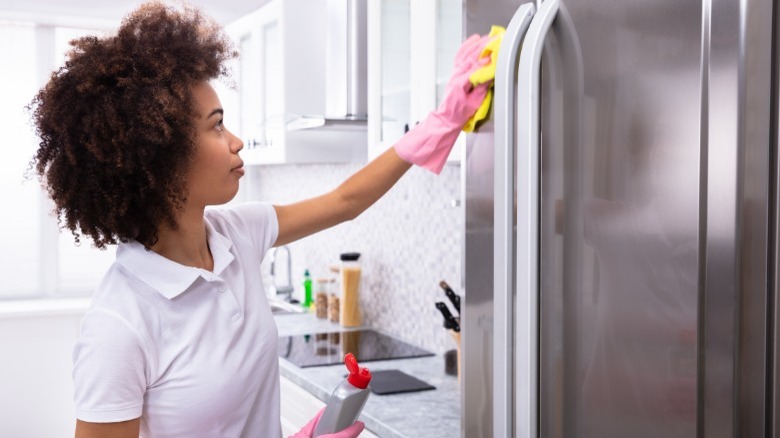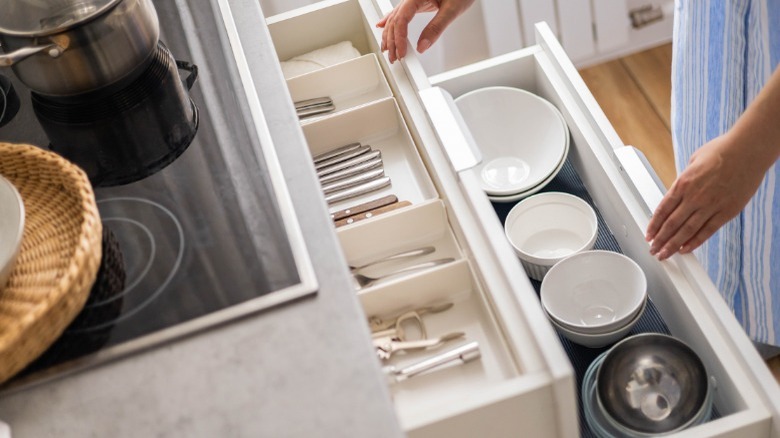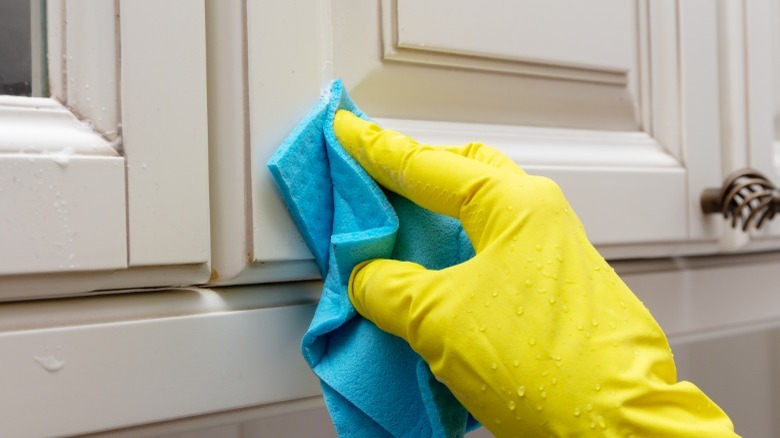Tips On How To Best Clean Your Kitchen
It's no secret that people consider kitchens the most important parts of their homes. Here's where the most time is spent cooking, eating, socializing, and yes, cleaning up. The best kitchen cleaning tips are effective, time-efficient, and will keep things cleaner for longer. According to Seattle Times, the five dirtiest places in a kitchen are the fridge, small appliances, countertops, sinks, and cooking utensils. Cleveland Clinic adds that kitchen towels and sponges are also hotspots for bacteria growth. We're talking about some nasty stuff here: Remember that last time someone said that they had stomach flu? It probably wasn't a virus but rather something that they ate. The University of Rochester Medical Center explains that when bacteria transfer between surfaces, it can cause food-borne illnesses.
Keeping kitchens sanitary is a priority for this reason, but no one wants to put their hand on a greasy countertop or look at a dirty kitchen floor, either. The Maids posts that it takes longer to clean a kitchen than a bathroom, which makes sense because kitchens are usually larger. Besides that, food prep stations must be sanitary, and cooking is messier than taking a shower. Here are the best ways to clean and sanitize your house's busiest and most-loved room.
Clean your oven the right way
Self-cleaning ovens are convenient, but not everyone has one. But even if you do, the cleaning cycle might produce a lot of smell and smoke, according to Home Depot. And sometimes, you still need to touch up the interior cavity afterward. To do that, remove any leftover ashes with a damp sponge. You can also mix up baking soda and vinegar and wipe things down.
To avoid harsh smells and potential fire hazards, try out Home Depot's all-natural method instead. Mix baking soda with water until you have a paste and spread it onto the oven's interior. Then, spray it with a 50/50 vinegar and water solution. This must sit for 12 hours, so do it before hitting the hay. The following day, wipe the oven down with a clean sponge or cloth and water. The window can be cleaned with a store-bought oven window cleaner, and the racks must be cleaned separately.
Empty and clean the fridge
Cleaning a refrigerator is more than just wiping it down; you have to scout through the contents and toss whatever has expired first. We recommend removing all of the fridge's contents, checking expiration dates, and (carefully) sniffing questionable items. How often should a fridge be cleaned? According to GQ, they can be spot cleaned as needed. A three- or four-month deep cleaning is recommended, and you can put your food in coolers with ice packs while working. That way, you won't feel rushed.
HomeServe explains the steps for cleaning out a refrigerator once the food is out. Take out removable shelves and drawers and let them come to room temperature (that prevents cracking). Those can be soaked in warm, sudsy water with a drop of ammonia. Use a scrub brush for stubborn gunk, rinse clean, and air dry. Clean the interior with a 1:7 ratio baking soda to water mixture, and use toothpicks and a toothbrush to get into the tight spots.
Do you have dried food splotches from condiments or leftovers? Disinfect the area with 3 parts water to 1 part of vinegar mixed into a spray bottle. Once the inside is cleaned and sanitized, the door gaskets can be cleaned with dish soap and water. You can use an all-purpose cleaner for the exterior, but if it's stainless steel, just use warm water and microfiber cloths.
Don't just wipe down the sink
Even if you wipe down your kitchen sink after dinner each night, it still needs a good cleaning once a week. Home Warranty of America warns that it could be the dirtiest spot in your home, and shares tips for cleaning porcelain and stainless-steel ones (these are the most common). To clean and disinfect, sprinkle on baking soda and mix equal parts of vinegar and water into a spray bottle. Spritz on the latter and let things bubble for a few minutes or so. Then, you can rinse and wipe it down. The vinegar spray also works wonders on dirty kitchen faucets.
Another option is to sprinkle salt on the sink and scrub with the open sides of lemon slices. This works well when there is dried, stuck-on debris on the surfaces. For porcelain sinks, mix up ¼ bleach cup in 1 gallon of warm water. This solution is a great disinfectant, but never use it on stainless steel.
What, your sink has a stink? Tap Warehouse comes to the rescue with a few ideas. First, pour in 2 liters of boiling water, wait five minutes, and pour in the same amount of cold water. Then, pour ½ cup of baking soda and 1 cup of white vinegar into the garbage disposal. Let that sit for a few hours before flushing it out with boiling water. If that doesn't work, it might be time to call a plumber.
Don't forget to clean the microwave
It's common to cook uncovered food and drinks in microwaves and then find colorful splatters all over the interiors. Rise and Shine Cleaning Service explains that those stains reheat each time the microwave is turned on, so those warmed-up germs can cross-contaminate whatever it is you're cooking. In addition to that, if there are thick stains in a microwave, they can catch fire. Other problems include bad smells and not being able to shut the door. Are you convinced that you need to clean your microwave now?
Slay at Home Mother shares a decent hack that can make it easier to clean cooked-on food stains in microwaves. She pours 2 cups of water into a (microwave-safe) container and adds 2 tablespoons of lemon juice. This gets placed inside the appliance and put on high heat for five minutes. While it's on, she cleans the outside with glass cleaner spritzed onto a microfiber cloth. After you hear the beep, put on a potholder, remove the lemon water, and put it aside. Take out the turntable and wipe it down in your sink. Then, you can wipe down the inside with a cloth or sponge, dipping it into the lemon water as needed.
Clean the insides of drawers and cupboards
Most every kitchen has at least one junk drawer, but you want to avoid having drawers full of crumbs, grease, and other debris. This can be a problem because of uninvited guests, and we're not talking about your nosy neighbors. Any Pest claims that bread, grains, nuts, and even pet food attract mice, cockroaches, ants ... you get the picture.
Clean My Space recommends an annual kitchen cupboard/drawer deep clean, but we suggest doing it three to four times a year, especially if there is food or drink in them. This can be a big job, so start by pulling everything out from the cupboards and counters. Using a hose attachment, vacuum all the debris out. Then, clean the interiors with an all-purpose cleaner and a microfiber cloth. Geaux Maids uses a mild, non-abrasive cleaning detergent to clean the insides of kitchen cabinets, and this can work just as well. Wipe the surfaces down with clean cloths when finished and leave them open until they dry. If you removed any cutlery trays, make sure to vacuum and clean them as well.
Clean the outsides of drawers and cabinets
It's not always easy to see dirt and grease outside cabinets and drawers, especially dark ones. But cleaning the exterior is important since touching cabinets after handling raw meat could spread bacteria, according to Superior Shop Drawings. Besides that, the handles can get gunky — who wants to touch that?
EverydayCheapskate cleans the outsides with a DIY wood cabinet cleaner made from Dawn dishwashing liquid, white vinegar, olive oil, and warm water mixed into a spray bottle. This source also suggests orange oil as a natural, effective cleaner. For stubborn stains, combine 2 parts baking soda and 1 part vegetable oil to make a paste. Keep scrubbing this thick paste into the wood with a clean cloth until the marks are gone.
Not all kitchen cabinets and drawers are made from wood, though. Kitchen Tune-Up recommends dusting laminate ones often (including the corners) with lint-free cloths. For a good cleaning, add a few drops of dishwashing liquid into an empty spray bottle, fill it up with warm water, and clean it with a sponge or microfiber cloth. It's important to wipe the laminate dry because it can crack or warp when too much moisture is absorbed.
Do the dishwasher
Your dishwasher's job is cleaning your cooking and serving ware, but you have a job, too: keeping the appliance nice and clean. Asurion explains that food deposits inside dishwashers can prevent them from working properly. Bits of food and grease can clog up the working parts, and your dishes could end up with spots on them.
The best thing about cleaning a dishwasher is that the appliance does the hard work for you. However, the filter needs to be cleaned out first, though. According to Whirlpool, the filter can get blocked with food debris and should be removed and cleaned out before moving on to the next part. It's located at the bottom of the dishwasher, underneath the lower rack. Look around the sprayer arm and in the corners if you don't see it. Turn the filter clockwise, and it should pop out. Rinse it in the sink, and if it's particularly cruddy, use a toothbrush and dishwashing liquid to clean it.
Put the filter back in and pour 2 cups of white vinegar into a measuring cup. Place this on the bottom rack and shut the dishwasher door; don't add dish detergent. Turn on a normal cycle without using the heated dry option. Allow the cycle to run, and you're done – it should smell nice and clean inside.
Shine up your stainless steel
Kitchens can have many stainless steel surfaces, from appliances to countertops to trim. They can also get stained and look dull when they aren't taken care of. Consumer Reports calls them magnets for grease and water spots and advises against using abrasives to clean them. Steel wool scouring pads, bleaches, and scouring powders are all no-nos.
Instead, add a bit of mild dish detergent to warm water and clean the stainless steel with a soft cloth. You can make a baking soda paste for tough stains that don't come off. Glass cleaners can be used to spot clean any rogue fingerprints that didn't come off after the first pass.
There's more than one way to clean stainless steel, though. Another option is to spray straight white vinegar onto the surfaces and wipe it in the same direction as the grain. You can also restore the shine with a bit of baby oil on a cloth; it makes stainless steel shine like new. Just make sure that the surfaces are completely clean before doing this.
Wash kitchen towels and sponges
Paper towels can be expensive, but used kitchen towels and cleaning cloths can quickly become unsanitary. In Food Protection Trends' Bacterial Occurence in Kitchen Hand Towels, a study of five large American cities revealed that food residue and moistness on kitchen dishcloths (and sponges) made them ideal breeding grounds for bacteria, including E.coli. How does this happen?
Bacteria can spread when kitchen towels are used to wipe unclean surfaces. If those towels aren't removed and cleaned properly, they can be reused and spread bacteria to hands, countertops, and who knows what else. Some people change them out daily, but you can wait a day or two longer if the towel wasn't used to mop up raw meat or seafood juice. The USDA recommends cleaning used kitchen towels on the hot cycle in washing machines; UNL adds that they should be dried on high heat afterward. As for used kitchen sponges, the USDA also posts that microwaving and boiling them can help, but these should be replaced often.
Do the kitchen countertops
We recommend doing this towards the end of kitchen cleaning since the other tasks will dirty your countertops. It can be tricky because you have to choose the correct product or DIY cleaners based on your countertop material. Merry Maids explains how to clean the most common kinds, including granite, soapstone, Corian, and laminate. It recommends dish soap and water on a microfiber cloth, but you must keep rinsing it out to get rid of the dirt. Never use vinegar because it can damage the finish, and avoid scouring pads and scrub brushes.
Real quartz countertops can be cleaned in the same way, and you can also use ammonia and glass cleaner to make them shine. But unless you use a disinfectant cleaning product, the countertops won't be sanitized with these methods. The Granite Place discourages using bleach because it can damage the surfaces. Instead, it recommends 70% rubbing alcohol, which evaporates quickly. It can be applied with clean cloths and only needs about 10 minutes to dry. This is also good for sanitizing kitchen handles, light switches, and knobs. Alcohol has a strong smell, but you can turn on a fan or open up some windows.
Vacuum and clean the rugs
Kitchen rugs add color and texture to floors and are often placed under dining tables. But unless you have a dog, dropped food and debris will accumulate in the fibers. Stains can also be left by food, drink, and yes, dogs. PROHousekeepers recommends vacuuming area rugs once a week at a minimum. If the rug is beneath a kitchen table, we suggest pulling back the chairs and moving the table aside to get beneath; you may be surprised at what you find, and it might not be pretty. If possible, flip the rug over and vacuum the back as well.
Machine-washable area rugs can be washed and dried while you clean the floor. Some rugs can be hand-washed, but you'll need a sunny, dry day for the best results. Lay the rug outside on a driveway or pavement and hose it down. Add a small amount of liquid laundry detergent and work it in with a brush. Then, you can rinse it out and let it air dry. Don't get it too wet because it could get damaged from oversaturation. If the rug is made from jute or another less common material, read the manufacturer's cleaning instructions.
Floor cleaning
Sweeping a kitchen floor after dinner every day is a great habit, and anyone who does this has our respect. However, weekly wet cleanings are still needed to keep the surfaces cleaner and more sanitary. As with cabinets and countertops, floor cleaning methods depend on the material. You'll want to sweep and vacuum the floor first, no matter what it's made from.
BuildDirect recommends cleaning vinyl floors with warm water and vinegar, or you can use a store-bought vinyl floor cleaner. Use dish soap to clean tough stains and dry the floor with clean towels. Ceramic floors can be mopped with a mild cleanser and warm water. Laminate floors can also be cleaned with warm water and vinegar and must be thoroughly dried when finished. Use a pH-neutral floor cleaning product if you have marble floors since harsh, acidic cleaners will damage them. Home Depot uses hardwood floor cleaners and spray-and-mop wood floor products on wood floors, pointing out the importance of not leaving any standing water on the surfaces.












